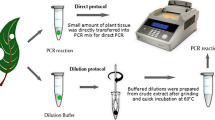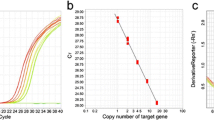Abstract.
Many protocols for genetic transformation result in the regeneration of both transformed shoots and untransformed ones known as escapes. Here we describe a multiplex PCR technique for use with apple (Malus × domestica Borkh.), which simultaneously demonstrates the presence of both a transgene sequence and an endogenous gene using a single PCR reaction. Common transgene-specific primers were successfully used in combination with either the conserved X1 primers or with different S-allele primers. When primers matched to S-allele sequences are used during multiplex PCR, the presence of the PCR product proves that amplification occurred successfully but can also confirm the identity of the cultivar used in the experiment. This is particularly useful as a protection against mislabeling of cultivars during subculturing and other laboratory and greenhouse operations.
Similar content being viewed by others
Author information
Authors and Affiliations
Corresponding author
Additional information
Revision received: 8 November 2000
Electronic Publication
Rights and permissions
About this article
Cite this article
Broothaerts, W., Wiersma, P. & Lane, W. Multiplex PCR combining transgene and S-allele control primers to simultaneously confirm cultivar identity and transformation in apple. Plant Cell Reports 20, 349–353 (2001). https://doi.org/10.1007/s002990100321
Received:
Accepted:
Published:
Issue Date:
DOI: https://doi.org/10.1007/s002990100321




